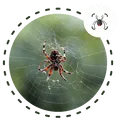The dark palm-dart is a swift-flying organism known for its darting flight pattern, often seen gliding near bamboos, its larval host plant. With compelling agility, adults display an apricot-orange hue on their wings, exhibiting vivid seasonal dimorphism. During the cooler months, they adopt darker, richer colors to absorb sunlight, whereas, in their summer form, lighter tones prevail for heat reflection. This species is a prime study for the relationship between wing coloration and thermoregulation.



















![]()

![]()










![]()
